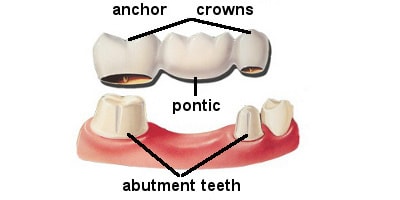
2 DAY PROCESS
A bridge is a fixed dental restoration used to replace one or more missing tooth by joining an artificial tooth definitively to adjacent teeth. A bridge will span the area where teeth are missing. They are attached to the natural teeth (called anchor).
The cost is based on each unit. A unit represents a tooth. The bridge will have a minimum of two anchor teeth. Typically, an anchor tooth on each side of the missing teeth/tooth.
Bridges: patients have two options for materials used to make the units on the bridge, either Zirconia or Porcelain Fused to High Noble Metal (PFM).
Porcelain fused to high noble metal (PFM). PFM bridges and crowns can be thought of as a hybrid as they are made from both all -metal and all-ceramic materials. A metal alloy is used to create a thin thimble-like “cap” that fits snugly over the tooth. Porcelain is then fused over the substructure to form the shape of the unit or crown and give it a white tooth-like appearance. Porcelain-fused-to-metal restorations have a 50+ year track record of providing lasting and durable service
- Advantages of PFM
- Due to differences in how they’re made, a PFM’s metal substructure typically achieves a more exacting fit over its tooth than an all-ceramic one.
- Even if some of its surface layer of porcelain fractures off, the metal substructure underneath will characteristically stay intact thus maintaining the crown’s seal over, and reinforcement of, the tooth. In comparison, the full thickness of an all-ceramic may fracture, thus compromising both functions.
- Disadvantages of PFM
- The issue of appearance is a difficulty with PFM’s. In situations where appearance is critical (like with incisors or eyeteeth, and especially in cases where just one or a few crowns are being placed), opting for an all-ceramic might make the better-matching choice. For bridges, the recommendation is to use Zirconia.
- For posterior teeth that show (like premolars and 1st molars) the added strength that a PFM offers might make its possibly just-average appearance an acceptable tradeoff.
- PFMs require a greater amount of tooth reduction (trimming) than their all-metal and Zirconia counterparts.
- Some people are allergic to the metals used.
- Corrosion is sometimes a concern with these materials.
How to take care of a dental bridge
- Avoid chewing hard food, ice or candy. Any of these can cause damage to the bridge or the teeth that hold the bridge in place.
- Grinding your teeth can cause damage to the crowns on either end of the bridge. Use a prosthetic aid (night guard) to assist you in stopping if you grind in your sleep.
- Purchase a good quality dental water pic. Do not floss in the bridge area. Water pic will keep the area clean. Brush as usual.
- If you experience any pain or problems, have them checked by your dentist. After a short healing period you should not notice any pain. If you do it could be an indication that the bridge has a “high spot” or gums are not healing properly, causing swelling. Please schedule an appointment if pain or irritation occurs after 5 days.
